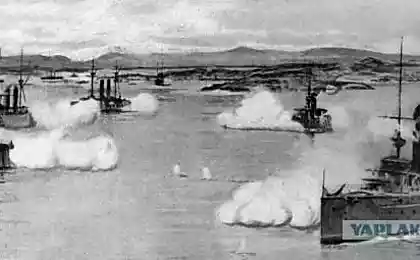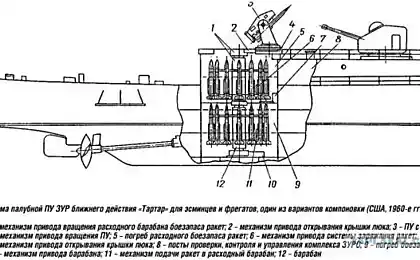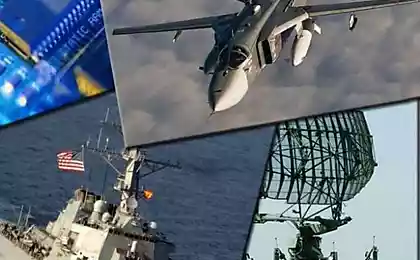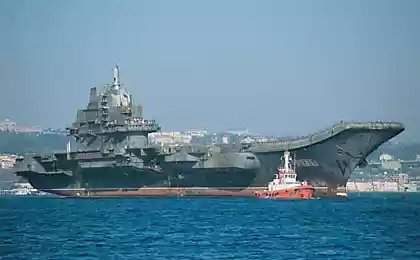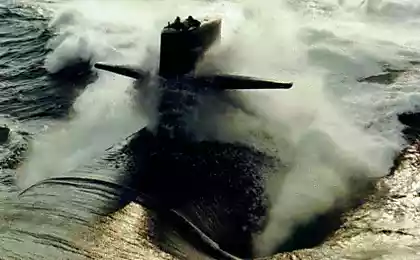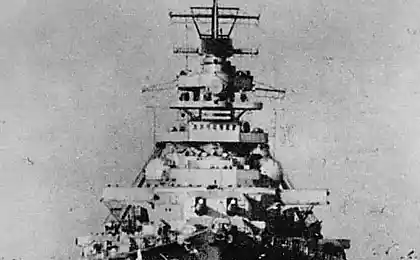1269
Nuclear-powered cruiser "Peter the Great" VS system "Aegis"
Strengthening the presence of the Russian Navy in the oceans responded to the flow of high-profile media reports: interviews, questions, predictions, comments and evaluation of domestic and foreign experts. The main "star" of the events, as usual, is a nuclear missile cruiser "Peter the Great" - the largest of neavianesuschih warships in the world, 26 000-ton giant with a monumental appearance of the imperial cruiser and three hundred missiles on board.
Whenever, at the mention of the name "Peter", the forums begins its comparison with foreign ships of the same class and destination. Of course, direct analogues of domestic TARKRa there - this cruiser is unique in its kind technical masterpiece. However, a number of parameters, you can pick rivals: the possibility of air defense "Peter" made to compare with the US Aegis cruisers (or destroyers - which, incidentally, is the same). And here is where the fun begins ...
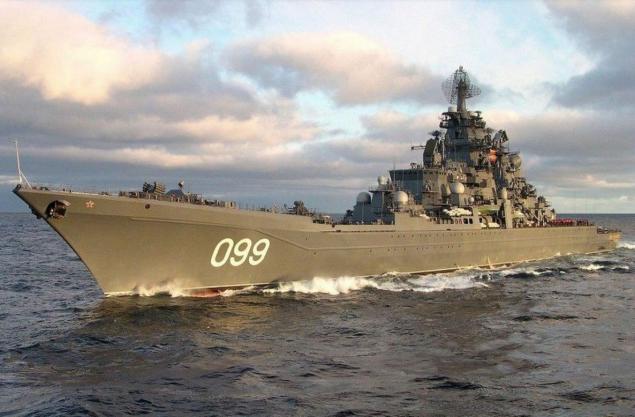
- Cruiser carries on board more than 200 anti-aircraft missiles, it will be enough at all - surely say patriots.
- No! - Yelling pro-American citizens - the combat system "Aegis" ("Aegis") is the whole world. Your cruiser just a puppy compared with the proven "Ticonderoga" and "Arleigh Burke".
- Go to hell! - Get angry supporters of the domestic fleet - on our cruiser are two sets of S-300 - just try to stick their noses!
- Shoot, cheap! - Respond to them from overseas - Ships Yankees able to hit targets in low Earth orbit - that's where the real and not ostentatious power!
Constructive dialogue does not happen as long as someone from vigilant citizens not to notice oddities in the appearance of the Russian cruiser: - Lord, why superstructure "Peter" look like a forest after the Chernobyl accident?
Artsy silhouette bulky pyramidal mast on everywhere stick spreading "branches" of the antenna devices of radars and communications systems ... The mere enumeration of this "zoo" can bring a smile: a complex radar "Peter the Great" includes radars, "Sunrise", "Frigate M2 "" Tackle "," positive "," Wave ", 4R48 with phased array antenna post 3R95, artillery fire control radar MR184" Lion "Finally, two navigation radar" Vaygach-In. "
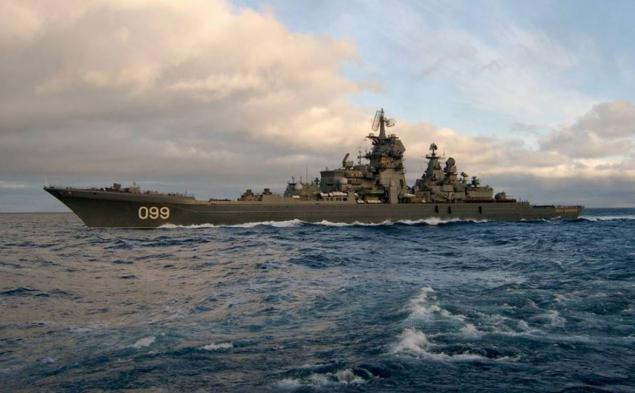
In addition to the overall non-rationality and complexity of work to harmonize such a large number of radio resources, sloppy appearance, "Peter" great increases its visibility - cruiser shines on enemy radar screens, like the brightest star. Certainly played a role "backward Bolshevik technology" ... but not to the same extent!
How did okay and modern, then, seems to be the American Aegis-type destroyer "Arleigh Burke" - the clean lines of superstructures made taking into account the technology "stealth", at least the outer decor elements, the only multi-purpose radar detection with fixed blades PAR. American "Burke" like a visitor from other worlds - his appearance is so unusual, compared with the ships of the Russian Navy.

But is it really? What are the "pitfalls" are hidden behind stylish way USS? And it is our outdated "Peter the Great", as it seems at first sight?
In the glamor of high technology, or avaricious pays twice
An American ship is built around a combat information management system "Aegis", combines all the means of detection, communications, weapons systems and the struggle for survival of the ship. Universal destroyers robots are able to exchange information with their peers and to make decisions for the commander. By creating such a system, the Yankees were 20 years old - a really serious development, which laid the most advanced ideas of modern naval combat: at the forefront is the instantaneous detection and breeding purposes. The first American ship will take a decision, the first shot and the first to destroy the opponent. The Pentagon calls the Aegis destroyers, the best maritime air defense system to date.
A key element of the system - radar AN / SPY-1 is a combination of four planar phased array antennas, fixed on each side of the superstructure of the destroyer. "Spy" is able to automatically search for the azimuth and elevation, to capture, classification and tracking hundreds of air targets, program autopilots anti-aircraft missiles on the launch and midcourse trajectory.
In the photo-type destroyer "Arleigh Burke»
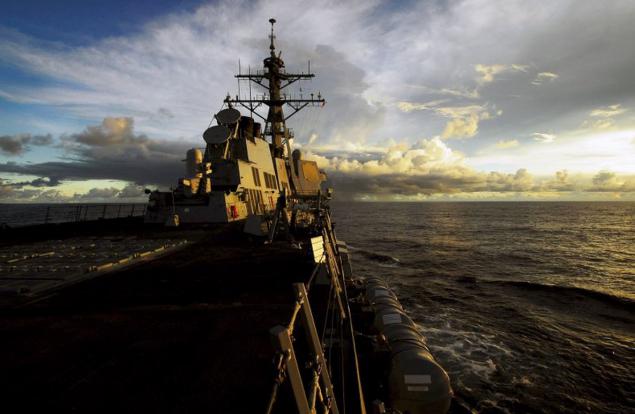
The use of a single multi-function radar allows us to simplify the collection and analysis of information, as well as to eliminate interference that occur on other ships at the large number of radar stations.
However, the apparent advantage of the SPY-1 hides a complex technical problem: How to teach effective radar target detection over large and small distances at the same time? UHF ("Spy" has a range of S) is well reflected from the sea surface - a barrage of noise makes it difficult to recognize rushing over the water rocket, making a destroyer totally defenseless against supersonic RCC. In addition, the low position of the antennas SPY-1 reduces the already small range of detection of low-flying targets, robbing the ship precious seconds required for the reaction to the threat.
Nobody in the world did not dare to repeat the trick with the American "one multifunction radar" - on projects warships set up in other countries, in addition to the general radar detection is always provided for the installation of specialized radar to detect low-flying targets:
- British "Daring" (decimeter panoramic S1850M + cm SAMPSON)
- Franco-Italian "Horizon» (S1850M + cm EMPAR)
- Japanese "Akidzuki" (dual-band FCS-3A with active phased arrays. In fact - two radars (C-band and X), under the general title).
But what about the discovery of ETI at Russian nuclear cruiser?
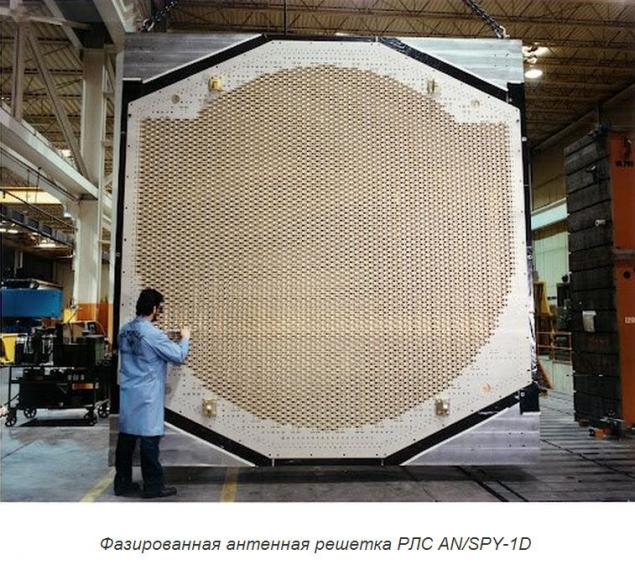
Radars "Peter the Great»
The Russian ship all right - detection of air targets assigned to the three radars for various purposes:
- A powerful overview radar MR-600 "Sunrise" (located at the top of the foremast - the first mast from the bow of the ship);
- Three-coordinate radar MR-750 "frigate M2" phased array (located on the top of the next lower mainmast);
- Specialized two coordinate radar MR-350 "Tackle" to detect low-flying targets (two antennas are located on the sites on each side of the foremast). The main feature of the station is a special radiation pattern with narrowed "side lobes" (scanning of the small elevation) and high frequency of data updates.
It is this radar is not enough US Aegis-destroyer.
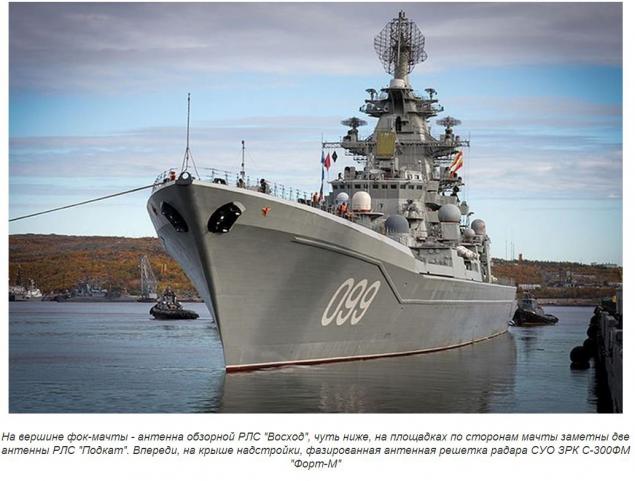
But find - does not mean to destroy. The goal must be to take the support, to bring her weapon and control the whole process of a missile to the target.
In shtatovskih ship is engaged, as usual, multi-function radar AN / SPY-1 radar, along with the three target illumination. Super-radar "Spy" is able to simultaneously control up to 18 anti-aircraft missiles ... 20: determine their position in space and automatically transmit on autopilot SAM corrective impulses guiding them to the desired sector of the sky. However, the system "Aegis" is careful that the number of missiles in the terminal phase of the trajectory does not exceed three units.
The trick is that most modern marine air defense system (including "Stenderd" and C-300F) using semi-active way of guidance: a special radar "illuminates" the purpose, the head of the missile responds to reflected "echo". It's simple. But the number of simultaneously engaged targets limited number of CMV radar illumination.
As mentioned above - had only three American destroyers radar AN / SPG-62. Course covers the corners of one, feed - two on board - all three together. The Russian nuclear cruiser situation is fundamentally different: missile guidance systems S-300F 300FM and involved two specialized radars, each of which provides support for SAM since its launch to hit the target:
- Radar with a phased antenna array 4R48 (flat "plate" in front of the superstructure, "Peter the Great"). Unlike the American AN / SPG-62, which provides simultaneous illumination of just one goal, the domestic system generates six channels targeting: all 4R48 can simultaneously direct up to 12 rockets at 6 aerial targets!
- Second radar - 3R41 "Wave", received the Navy for the characteristic shape of the nickname "tit" (clearly visible on the aft part of the superstructure). In fact, at this point to establish a modern breaded 4R48, but, alas, in the construction of the cruiser only enough funds to "boob", and modern 4R48 were sold abroad and installed on board the Chinese destroyers like "Liuzhou».
As a result, by the stern "Peter" is capable of inducing a total of 6 missiles at three targets - but, in any case, it is the best result compared with US Aegis-destroyer.
In addition to a larger number of control channels, the national scheme of fire control radars on the basis of specialized 3R41 and 4R48 provides a much more reliable and noiseless guidance of missiles in midcourse, compared with US multifunction AN / SPY-1.

In contrast to the US Aegis-destroyer, which aiming all types of anti-aircraft missiles ("stenderd 2, 3", "B Sparrow», ESSM) oosuschestvlyaetsya single fire control system (SPY-1 + three SPG-62), the Russian cruiser It is equipped with two types of air defense systems to individual guidance systems. Also zoned S-300F / 300FM, on board the "Peter" is installed anti-aircraft system of self-defense "Dagger" - 128 short-range missiles, designed to repel attacks anti-ship missiles.
"Dagger" has its own antenna post 3R95, located in the aft part of the superstructure, near the paired pieces of artillery. Anti-aircraft complex uses a 4-channel radio command system that provides guidance to 8 simultaneous launch of four air targets in the sector of 60 ° x 60 °.
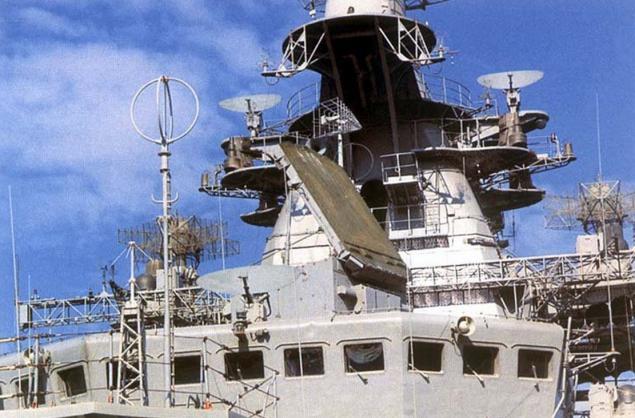
The last line of defense "Peter" is formed by six anti-aircraft artillery systems "Dagger" - each combat unit is a coaxial machine gun caliber 30 mm (total rate of fire rds 10,000. / Min), coupled with the unit anti-aircraft missiles 9M311 short range. Apart from its own radar, "Daggers" is produced from the two target designation radar antenna stations "Positive».
The American cruisers and destroyers in this case is much sadder - on board the "Arleigh Burke" in the best case, is mounted a pair of automated anti-aircraft guns "Phalanx" is a set of sextuple of 20 mm cannon and compact radar fire control, mounted on a gun carriage. In connection with efforts to reduce the cost of their construction, the destroyers of the US Navy last series generally devoid of any anti-aircraft defense.
Actually, "Arleigh Burke" deprived of many things - fi-Aegis destroyers, positioned by the Pentagon as the best warships air defense / missile defense do not have any special radar to detect NLTS nor a sufficient number of radar illumination purposes. This explains the nice eyes "smoothness" of superstructures and the absence of "superfluous" antennas.
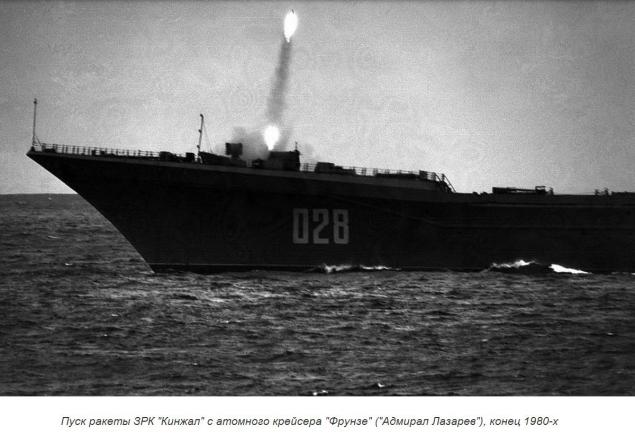
Epilogue
"Frigate", "Tackle", "Wave" ... Each radar has a specific purpose and is focused on the performance of some of its specific objectives. Combine them into a single "universal" station - an attractive idea, but difficult to realize in practice in the way engineers stand the fundamental laws of nature - each case is preferable to work in a certain wavelength range.
It is no coincidence, one of the most advanced developments in the field of marine detection equipment - a promising radar AN / SPY-3 with three AESA planned to be installed on the USS "Zamvolt" was originally created as part of a system of two radars: centimeter AN / SPY- 3 to search for low-altitude surveillance purposes and AN / SPY-4 (UHF range). Later, under the impact of financial cuts, the Pentagon refused to install AN / SPY-4, with the wording "the destroyer is not designed to provide air defense zone." Simply put, the super-destroyer "Zamvolt" not be able to effectively engage air targets at ranges of over 50 km (but, unlike "Burke" who knows how to shoot down satellites, "Zamvolt" ideal in repelling attack low-flying RCC).
The Yankees, as we know, are big fans of standardization and unification - now let them choose what is best ...
In contrast to the US "Aegis" and "Zamvoltov" Russian nuclear cruiser carries a complete set of tools to detect and control fire to destroy air targets at any distance. Even now, in view of the deliberate weakening of its characteristics due to the known events of political and economic nature, heavy nuclear missile cruiser "Pyotr Veliky" remains strong fighting unit, whose capabilities in terms of air defense, equivalent to two or three American Aegis-destroyers.
In the construction of this giant has great potential - replacing outdated radar "Sunrise" with a modern radar with active phased array, similar to the European S1850M and equipping of the ship missile system S-400 with the replacement of the ammunition to anti-aircraft missiles with active homing - turns the cruiser into an impregnable sea fortress .
Author Oleg Kaptsov
Via topwar.ru/2013/11/13/atomnyy-kreyse...emy-idzhis.html
Thank you all for your attention! And thank you, that is not broke!
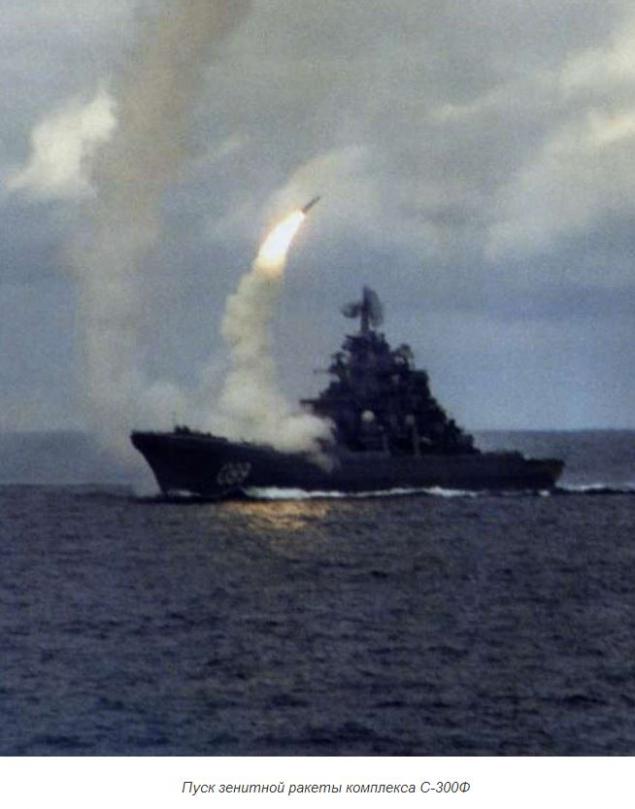
Source:
Whenever, at the mention of the name "Peter", the forums begins its comparison with foreign ships of the same class and destination. Of course, direct analogues of domestic TARKRa there - this cruiser is unique in its kind technical masterpiece. However, a number of parameters, you can pick rivals: the possibility of air defense "Peter" made to compare with the US Aegis cruisers (or destroyers - which, incidentally, is the same). And here is where the fun begins ...

- Cruiser carries on board more than 200 anti-aircraft missiles, it will be enough at all - surely say patriots.
- No! - Yelling pro-American citizens - the combat system "Aegis" ("Aegis") is the whole world. Your cruiser just a puppy compared with the proven "Ticonderoga" and "Arleigh Burke".
- Go to hell! - Get angry supporters of the domestic fleet - on our cruiser are two sets of S-300 - just try to stick their noses!
- Shoot, cheap! - Respond to them from overseas - Ships Yankees able to hit targets in low Earth orbit - that's where the real and not ostentatious power!
Constructive dialogue does not happen as long as someone from vigilant citizens not to notice oddities in the appearance of the Russian cruiser: - Lord, why superstructure "Peter" look like a forest after the Chernobyl accident?
Artsy silhouette bulky pyramidal mast on everywhere stick spreading "branches" of the antenna devices of radars and communications systems ... The mere enumeration of this "zoo" can bring a smile: a complex radar "Peter the Great" includes radars, "Sunrise", "Frigate M2 "" Tackle "," positive "," Wave ", 4R48 with phased array antenna post 3R95, artillery fire control radar MR184" Lion "Finally, two navigation radar" Vaygach-In. "

In addition to the overall non-rationality and complexity of work to harmonize such a large number of radio resources, sloppy appearance, "Peter" great increases its visibility - cruiser shines on enemy radar screens, like the brightest star. Certainly played a role "backward Bolshevik technology" ... but not to the same extent!
How did okay and modern, then, seems to be the American Aegis-type destroyer "Arleigh Burke" - the clean lines of superstructures made taking into account the technology "stealth", at least the outer decor elements, the only multi-purpose radar detection with fixed blades PAR. American "Burke" like a visitor from other worlds - his appearance is so unusual, compared with the ships of the Russian Navy.

But is it really? What are the "pitfalls" are hidden behind stylish way USS? And it is our outdated "Peter the Great", as it seems at first sight?
In the glamor of high technology, or avaricious pays twice
An American ship is built around a combat information management system "Aegis", combines all the means of detection, communications, weapons systems and the struggle for survival of the ship. Universal destroyers robots are able to exchange information with their peers and to make decisions for the commander. By creating such a system, the Yankees were 20 years old - a really serious development, which laid the most advanced ideas of modern naval combat: at the forefront is the instantaneous detection and breeding purposes. The first American ship will take a decision, the first shot and the first to destroy the opponent. The Pentagon calls the Aegis destroyers, the best maritime air defense system to date.
A key element of the system - radar AN / SPY-1 is a combination of four planar phased array antennas, fixed on each side of the superstructure of the destroyer. "Spy" is able to automatically search for the azimuth and elevation, to capture, classification and tracking hundreds of air targets, program autopilots anti-aircraft missiles on the launch and midcourse trajectory.
In the photo-type destroyer "Arleigh Burke»

The use of a single multi-function radar allows us to simplify the collection and analysis of information, as well as to eliminate interference that occur on other ships at the large number of radar stations.
However, the apparent advantage of the SPY-1 hides a complex technical problem: How to teach effective radar target detection over large and small distances at the same time? UHF ("Spy" has a range of S) is well reflected from the sea surface - a barrage of noise makes it difficult to recognize rushing over the water rocket, making a destroyer totally defenseless against supersonic RCC. In addition, the low position of the antennas SPY-1 reduces the already small range of detection of low-flying targets, robbing the ship precious seconds required for the reaction to the threat.
Nobody in the world did not dare to repeat the trick with the American "one multifunction radar" - on projects warships set up in other countries, in addition to the general radar detection is always provided for the installation of specialized radar to detect low-flying targets:
- British "Daring" (decimeter panoramic S1850M + cm SAMPSON)
- Franco-Italian "Horizon» (S1850M + cm EMPAR)
- Japanese "Akidzuki" (dual-band FCS-3A with active phased arrays. In fact - two radars (C-band and X), under the general title).
But what about the discovery of ETI at Russian nuclear cruiser?

Radars "Peter the Great»
The Russian ship all right - detection of air targets assigned to the three radars for various purposes:
- A powerful overview radar MR-600 "Sunrise" (located at the top of the foremast - the first mast from the bow of the ship);
- Three-coordinate radar MR-750 "frigate M2" phased array (located on the top of the next lower mainmast);
- Specialized two coordinate radar MR-350 "Tackle" to detect low-flying targets (two antennas are located on the sites on each side of the foremast). The main feature of the station is a special radiation pattern with narrowed "side lobes" (scanning of the small elevation) and high frequency of data updates.
It is this radar is not enough US Aegis-destroyer.

But find - does not mean to destroy. The goal must be to take the support, to bring her weapon and control the whole process of a missile to the target.
In shtatovskih ship is engaged, as usual, multi-function radar AN / SPY-1 radar, along with the three target illumination. Super-radar "Spy" is able to simultaneously control up to 18 anti-aircraft missiles ... 20: determine their position in space and automatically transmit on autopilot SAM corrective impulses guiding them to the desired sector of the sky. However, the system "Aegis" is careful that the number of missiles in the terminal phase of the trajectory does not exceed three units.
The trick is that most modern marine air defense system (including "Stenderd" and C-300F) using semi-active way of guidance: a special radar "illuminates" the purpose, the head of the missile responds to reflected "echo". It's simple. But the number of simultaneously engaged targets limited number of CMV radar illumination.
As mentioned above - had only three American destroyers radar AN / SPG-62. Course covers the corners of one, feed - two on board - all three together. The Russian nuclear cruiser situation is fundamentally different: missile guidance systems S-300F 300FM and involved two specialized radars, each of which provides support for SAM since its launch to hit the target:
- Radar with a phased antenna array 4R48 (flat "plate" in front of the superstructure, "Peter the Great"). Unlike the American AN / SPG-62, which provides simultaneous illumination of just one goal, the domestic system generates six channels targeting: all 4R48 can simultaneously direct up to 12 rockets at 6 aerial targets!
- Second radar - 3R41 "Wave", received the Navy for the characteristic shape of the nickname "tit" (clearly visible on the aft part of the superstructure). In fact, at this point to establish a modern breaded 4R48, but, alas, in the construction of the cruiser only enough funds to "boob", and modern 4R48 were sold abroad and installed on board the Chinese destroyers like "Liuzhou».
As a result, by the stern "Peter" is capable of inducing a total of 6 missiles at three targets - but, in any case, it is the best result compared with US Aegis-destroyer.
In addition to a larger number of control channels, the national scheme of fire control radars on the basis of specialized 3R41 and 4R48 provides a much more reliable and noiseless guidance of missiles in midcourse, compared with US multifunction AN / SPY-1.

In contrast to the US Aegis-destroyer, which aiming all types of anti-aircraft missiles ("stenderd 2, 3", "B Sparrow», ESSM) oosuschestvlyaetsya single fire control system (SPY-1 + three SPG-62), the Russian cruiser It is equipped with two types of air defense systems to individual guidance systems. Also zoned S-300F / 300FM, on board the "Peter" is installed anti-aircraft system of self-defense "Dagger" - 128 short-range missiles, designed to repel attacks anti-ship missiles.
"Dagger" has its own antenna post 3R95, located in the aft part of the superstructure, near the paired pieces of artillery. Anti-aircraft complex uses a 4-channel radio command system that provides guidance to 8 simultaneous launch of four air targets in the sector of 60 ° x 60 °.

The last line of defense "Peter" is formed by six anti-aircraft artillery systems "Dagger" - each combat unit is a coaxial machine gun caliber 30 mm (total rate of fire rds 10,000. / Min), coupled with the unit anti-aircraft missiles 9M311 short range. Apart from its own radar, "Daggers" is produced from the two target designation radar antenna stations "Positive».
The American cruisers and destroyers in this case is much sadder - on board the "Arleigh Burke" in the best case, is mounted a pair of automated anti-aircraft guns "Phalanx" is a set of sextuple of 20 mm cannon and compact radar fire control, mounted on a gun carriage. In connection with efforts to reduce the cost of their construction, the destroyers of the US Navy last series generally devoid of any anti-aircraft defense.
Actually, "Arleigh Burke" deprived of many things - fi-Aegis destroyers, positioned by the Pentagon as the best warships air defense / missile defense do not have any special radar to detect NLTS nor a sufficient number of radar illumination purposes. This explains the nice eyes "smoothness" of superstructures and the absence of "superfluous" antennas.

Epilogue
"Frigate", "Tackle", "Wave" ... Each radar has a specific purpose and is focused on the performance of some of its specific objectives. Combine them into a single "universal" station - an attractive idea, but difficult to realize in practice in the way engineers stand the fundamental laws of nature - each case is preferable to work in a certain wavelength range.
It is no coincidence, one of the most advanced developments in the field of marine detection equipment - a promising radar AN / SPY-3 with three AESA planned to be installed on the USS "Zamvolt" was originally created as part of a system of two radars: centimeter AN / SPY- 3 to search for low-altitude surveillance purposes and AN / SPY-4 (UHF range). Later, under the impact of financial cuts, the Pentagon refused to install AN / SPY-4, with the wording "the destroyer is not designed to provide air defense zone." Simply put, the super-destroyer "Zamvolt" not be able to effectively engage air targets at ranges of over 50 km (but, unlike "Burke" who knows how to shoot down satellites, "Zamvolt" ideal in repelling attack low-flying RCC).
The Yankees, as we know, are big fans of standardization and unification - now let them choose what is best ...
In contrast to the US "Aegis" and "Zamvoltov" Russian nuclear cruiser carries a complete set of tools to detect and control fire to destroy air targets at any distance. Even now, in view of the deliberate weakening of its characteristics due to the known events of political and economic nature, heavy nuclear missile cruiser "Pyotr Veliky" remains strong fighting unit, whose capabilities in terms of air defense, equivalent to two or three American Aegis-destroyers.
In the construction of this giant has great potential - replacing outdated radar "Sunrise" with a modern radar with active phased array, similar to the European S1850M and equipping of the ship missile system S-400 with the replacement of the ammunition to anti-aircraft missiles with active homing - turns the cruiser into an impregnable sea fortress .
Author Oleg Kaptsov
Via topwar.ru/2013/11/13/atomnyy-kreyse...emy-idzhis.html
Thank you all for your attention! And thank you, that is not broke!

Source:

